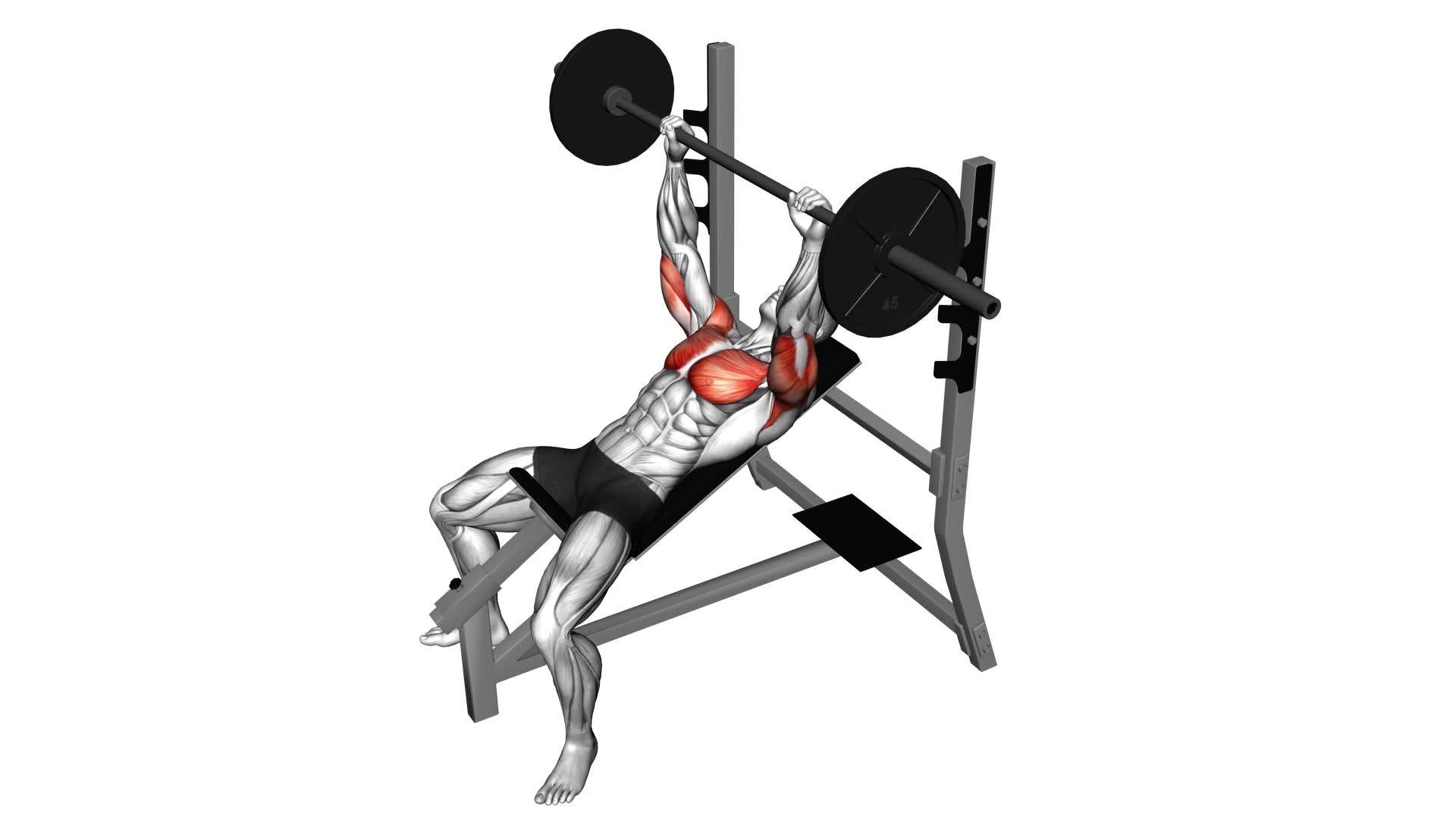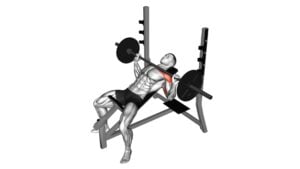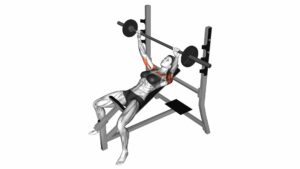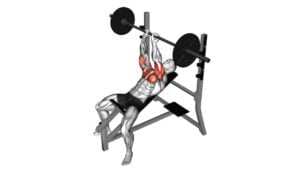Barbell Incline Bench Press – Video Exercise Guide & Tips

Looking to maximize your chest muscle engagement? The Barbell Incline Bench Press is a great exercise to add to your routine.
Watch This Exercise Video
In this video exercise guide, we'll show you the proper technique and form, as well as variations for advanced lifters.
Avoid common mistakes and get the most out of your workout with our helpful tips.
Get ready to take your chest gains to the next level!
Key Takeaways
- Targets different muscle groups effectively
- Engages upper body muscles with different grips
- Activates shoulders, especially anterior deltoids
- Enhances upper chest muscle activation
Benefits of Barbell Incline Bench Press
Experience the numerous benefits of the barbell incline bench press. This exercise offers several advantages, including the ability to target different muscle groups and activate them effectively.
By using different grips during the barbell incline bench press, you can engage various muscles in your upper body. For instance, a close grip focuses on your triceps, while a wider grip emphasizes your chest muscles.
This exercise also activates your shoulders, especially the anterior deltoids. The incline angle of the bench further enhances muscle activation in the upper chest area.
By incorporating the barbell incline bench press into your workout routine, you can achieve a well-rounded upper body development. Moreover, this exercise helps in improving your overall pressing strength, which can be beneficial for other exercises like the bench press and overhead press.
With proper form and technique, the barbell incline bench press can be an effective tool to build strength and muscle in your upper body.
Proper Technique and Form
To perform the barbell incline bench press with proper technique and form, follow these steps.
- Start by adjusting the incline bench to an angle of around 30-45 degrees.
- Lie down on the bench with your feet firmly planted on the ground and your back flat against the bench.
- Grab the barbell with a grip slightly wider than shoulder-width apart, making sure your wrists are straight.
- Unrack the barbell and lower it slowly towards your upper chest while keeping your elbows tucked in.
- Pause for a brief moment, then push the barbell back up using your chest muscles until your arms are fully extended.
- Remember to exhale as you push the barbell up and inhale as you lower it down.
- It's crucial to maintain control throughout the movement and avoid bouncing the barbell off your chest.
- This will ensure proper chest muscle activation and prevent injury.
- Repeat for the desired number of reps.
Variations for Advanced Lifters
If you're an advanced lifter, you can challenge yourself with various variations of the barbell incline bench press. Here are some options to help you take your workout to the next level:
- Progressive overload techniques: To continue making gains, you can incorporate progressive overload techniques into your barbell incline bench press. This involves gradually increasing the weight you lift over time. By consistently challenging your muscles with heavier loads, you can stimulate further muscle growth and strength development.
- Incorporating resistance bands: Another way to add intensity to your barbell incline bench press is by incorporating resistance bands. Attach the bands to the barbell and anchor them to the bench or a sturdy object. The bands will create additional resistance at the top of the movement, making it harder to press the barbell. This can help improve your explosive power and overall strength.
- Negative reps: Negative reps involve focusing on the lowering phase of the exercise. For the barbell incline bench press, this means emphasizing the controlled descent of the barbell. By slowing down the lowering phase and focusing on the eccentric contraction, you can increase muscle tension and stimulate further muscle growth.
Common Mistakes to Avoid
To maximize the effectiveness of your barbell incline bench press and prevent injury, it is crucial to be aware of common mistakes to avoid. Proper form is essential for getting the most out of this exercise while minimizing the risk of injury. Here are some common mistakes to watch out for:
| Common Mistakes | Proper Form | Why it's Important |
|---|---|---|
| Arching your back | Keep your back flat against the bench | Arching your back can put unnecessary strain on your spine and decrease the effectiveness of the exercise. |
| Using too much weight | Start with a weight you can handle with proper form | Using excessive weight can compromise your form and increase the risk of injury. Focus on gradually increasing the weight as you get stronger. |
| Flaring your elbows outwards | Keep your elbows at a 45-degree angle | Flaring your elbows can strain your shoulders and reduce the effectiveness of the exercise for your chest muscles. |
| Bouncing the barbell off your chest | Lower the barbell under control and pause briefly at your chest | Bouncing the barbell can lead to muscle strains and diminish the effectiveness of the exercise. Control the movement throughout the range of motion. |
Tips for Maximizing Chest Muscle Engagement
To maximize chest muscle engagement during the barbell incline bench press, focus on proper form and technique. Here are some tips to effectively activate your chest muscles and target your upper chest muscles:
- Start with the right bench angle: Set the incline bench at a 30-45 degree angle. This will place more emphasis on the upper chest, helping you target this area effectively.
- Maintain a controlled descent: Lower the barbell slowly and under control, allowing your chest muscles to fully engage and work throughout the movement. Avoid bouncing the barbell off your chest, as this can reduce muscle activation and increase the risk of injury.
- Squeeze your chest at the top: When you reach the top of the movement, squeeze your chest muscles together for a brief moment before lowering the barbell again. This contraction will maximize the stimulation of your chest muscles.
Frequently Asked Questions
How Often Should I Incorporate Barbell Incline Bench Press Into My Workout Routine?
To incorporate barbell incline bench press into your workout routine, consider your fitness goals and current level of strength. This exercise targets your upper chest, shoulders, and triceps, providing a well-rounded upper body workout.
Start by adding it to your routine once a week and gradually increase frequency as your strength improves.
The benefits of barbell incline bench press include increased upper body strength, improved muscle definition, and enhanced overall athletic performance.
Can Barbell Incline Bench Press Help Improve My Overall Upper Body Strength?
Incorporating the barbell incline bench press into your strength training program can greatly improve your overall upper body strength. This exercise targets your chest, shoulders, and triceps, helping to increase muscle mass and definition.
To perform it properly, lie back on a bench set at a 45-degree angle, grip the barbell with a slightly wider than shoulder-width grip, and lower it to your chest before pushing it back up.
Is Barbell Incline Bench Press Suitable for Beginners?
Yes, the barbell incline bench press is suitable for beginners. It's a great exercise that can benefit your upper body strength.
To perform it properly, lie on an incline bench with your feet flat on the floor. Grip the barbell with your hands slightly wider than shoulder-width apart and lower it to your chest.
Push the barbell back up to the starting position. Remember to start with lighter weights and focus on maintaining proper form to avoid injury.
What Other Exercises Can I Include in My Workout Routine to Complement Barbell Incline Bench Press?
To complement the barbell incline bench press, you can include alternative exercises in your workout routine. Incorporating exercises such as dumbbell incline bench press, incline push-ups, and cable flyes can target your upper chest muscles effectively.
These exercises provide similar benefits as the barbell incline bench press, such as enhancing upper body strength, promoting muscle growth, and improving overall chest development.
Can Barbell Incline Bench Press Help With Improving Posture and Reducing Upper Back Pain?
Yes, the barbell incline bench press can help improve your posture and reduce upper back pain.
By targeting the muscles in your upper body, such as your chest, shoulders, and upper back, this exercise can strengthen these muscles, which in turn can help improve your posture.
Additionally, by strengthening these muscles, it can alleviate upper back pain by providing support and stability to the area.
Conclusion
In conclusion, the barbell incline bench press is an effective exercise for developing the chest muscles. By using proper technique and form, advanced lifters can also benefit from various variations of this exercise.
It's important to avoid common mistakes and focus on maximizing chest muscle engagement for optimal results. Incorporating the barbell incline bench press into your workout routine can help you achieve a stronger and more defined chest.

Author
Years ago, the spark of my life’s passion ignited in my mind the moment I stepped into the local gym for the first time. The inaugural bead of perspiration, the initial endeavor, the very first surge of endorphins, and a sense of pride that washed over me post-workout marked the beginning of my deep-seated interest in strength sports, fitness, and sports nutrition. This very curiosity blossomed rapidly into a profound fascination, propelling me to earn a Master’s degree in Physical Education from the Academy of Physical Education in Krakow, followed by a Sports Manager diploma from the Jagiellonian University. My journey of growth led me to gain more specialized qualifications, such as being a certified personal trainer with a focus on sports dietetics, a lifeguard, and an instructor for wellness and corrective gymnastics. Theoretical knowledge paired seamlessly with practical experience, reinforcing my belief that the transformation of individuals under my guidance was also a reflection of my personal growth. This belief holds true even today. Each day, I strive to push the boundaries and explore new realms. These realms gently elevate me to greater heights. The unique combination of passion for my field and the continuous quest for growth fuels my drive to break new ground.







